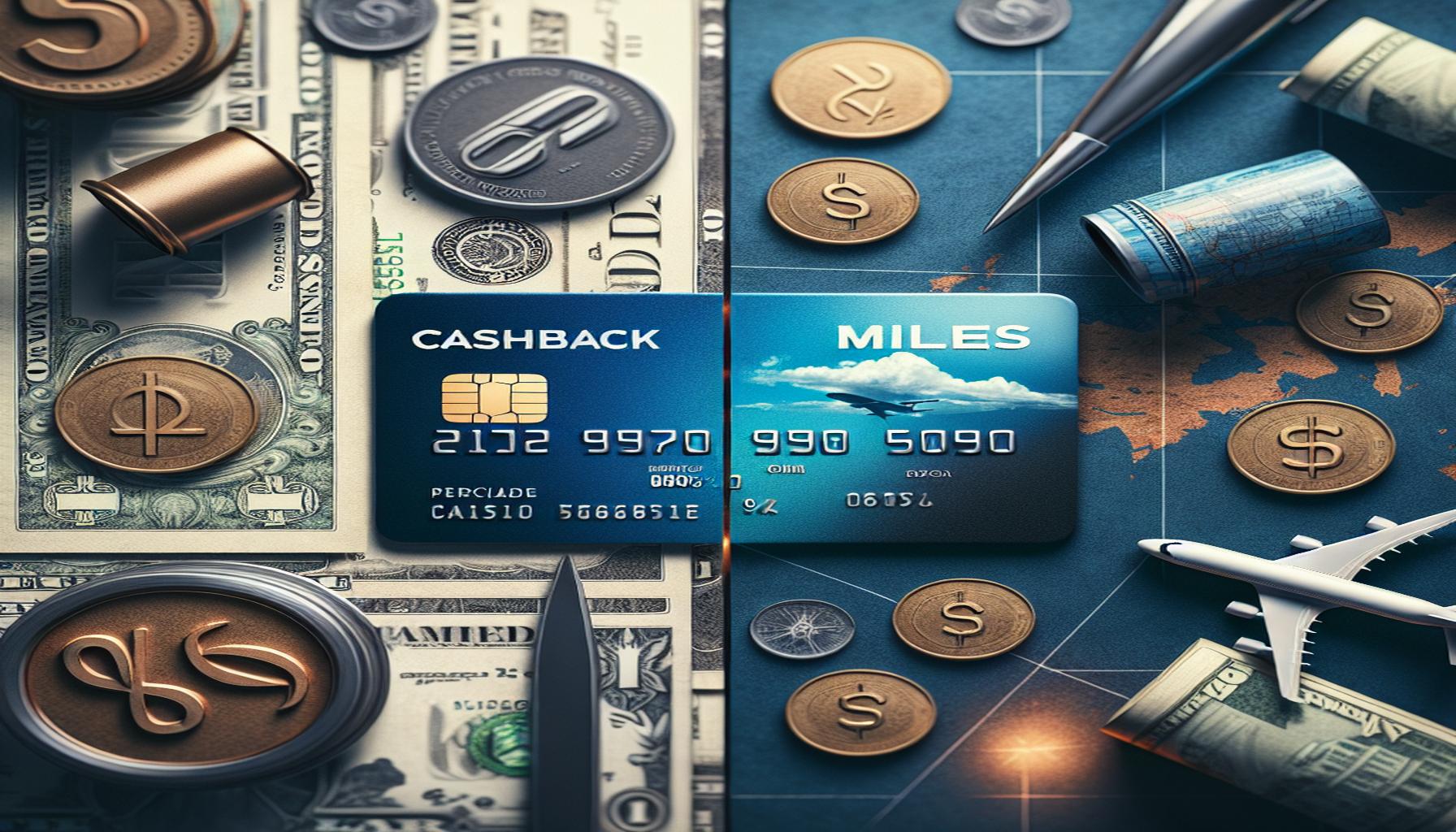Difference between cashback credit cards and miles

Understanding the Basics
Credit cards come with various rewards programs, which can often be confusing. Among the most popular types are cashback credit cards and those that earn miles. Each option offers unique benefits and drawbacks that cater to different financial habits and preferences.
Cashback Credit Cards
Cashback credit cards provide consumers with a percentage of their purchases back as cash. These cards are particularly appealing for individuals who prefer a straightforward rewards structure. Here are some features to consider:
- Instant rewards: With cashback cards, you receive cash back on everyday expenses, ranging from groceries to petrol. For example, if you use a cashback card that offers 2% back on all purchases, spending $100 on groceries would earn you $2 in rewards.
- No restrictions: The cash you earn can be used anywhere, anytime, without restrictions. This flexibility allows you to apply your rewards towards your next bill, indulge in a treat, or even save for a larger purchase, such as a family holiday.
- Flexibility: Cashback programs tend to be straightforward. They are great for those who want an easy-to-understand rewards system without complicating factors.
Miles Credit Cards
On the other hand, miles credit cards reward you with points that can be redeemed for travel-related benefits. If you love exploring new destinations or frequently fly for work, these cards can be extremely advantageous. Consider the following traits of miles cards:
- Travel-focused: Miles cards are ideal for frequent flyers looking to save on airfare. For instance, if you frequently travel between Sydney and Melbourne, accumulating points from a miles card can reduce your flight expenses significantly when redeemed.
- Partnership programs: Many miles cards are tied to specific airlines and hotel chains, offering additional points when booked through these partners. This aspect means that savvy travellers can enhance their rewards by planning travel with this in mind.
- Potential for greater value: Miles can sometimes provide high redemption values, especially when used for long-haul flights or premium seats, which might not be the case with cashback options.
Making the Right Choice
Ultimately, your choice between cashback and miles cards should depend on your spending habits and lifestyle needs. Consider what aligns best with your financial goals:
- Would you benefit more from regular cash back that can be used immediately for everyday purchases?
- Are you planning extensive travel in the future, which would make a miles card a more appealing option?
By understanding these differences and evaluating your spending patterns, you can make informed decisions that suit your individual needs. Whether you opt for a cashback card for immediate rewards or a miles card for future travel adventures, taking the time to assess your options can lead to greater financial satisfaction.
Cashback Credit Cards Explained
When you opt for a cashback credit card, you engage in a rewards system that is designed to provide you with immediate financial benefits based on your spending. This type of card can be particularly beneficial for consumers who make regular purchases in everyday categories. Knowing the exact terms of the cashback program is crucial, as different cards may offer varying rates for different spending categories. Some key features to consider are:
- Tiered cashback rates: Many cashback cards operate on a tiered system where a cardholder earns a higher percentage back on certain categories like groceries or fuel, while a lower percentage applies to other purchases. For instance, a card may offer 5% cashback on groceries, 3% on dining, and 1% on all other purchases.
- No expiration of rewards: Another appealing benefit of cashback cards is that the rewards generally do not expire, allowing cardholders to accumulate cash over time without the pressure of losing it. This means you can save your cashback for a bigger goal or spend it whenever you choose.
- Easy redemption: Redeeming cashback is often straightforward. Cardholders can typically apply their cash back directly to their statement balance or transfer it to a bank account. This accessibility allows individuals to enjoy their rewards without complex restrictions.
The Appeal of Miles Credit Cards
On the flip side, miles credit cards are tailored toward those who love to travel and are willing to plan their spendings to maximize their rewards for flights and hotel stays. They often come with unique benefits that appeal to frequent flyers. Here are some significant points to consider:
- Earning structure: Miles are usually earned based on the amount spent, with variations in the rate depending on where the purchase is made (i.e., more miles for travel-related expenditures). For example, using a miles card for a flight ticket may earn you 2-3 miles per dollar spent, while regular purchases might earn you only 1 mile per dollar.
- Exclusive travel perks: Many miles credit cards offer additional benefits like complimentary travel insurance, priority boarding, and lounge access. These perks enhance the travel experience, making miles cards particularly attractive for those who frequently fly.
- Redemption options: The ability to redeem miles for flights, hotel stays, or travel upgrades adds an extra layer of flexibility. However, understanding the nuances, such as blackout dates or specific redemption intervals, is vital to maximizing the value of your accumulated points.
In summary, cashback credit cards offer straightforward rewards for regular spending, while miles cards cater to travel enthusiasts. By weighing these features carefully, you can decide which rewards program aligns better with your lifestyle and spending habits.
Understanding the Trade-offs Between Cashback and Miles
While both cashback credit cards and miles credit cards have their appealing features, understanding the trade-offs is essential in making an informed choice. Depending on your financial habits and personal goals, one type of card may offer more value than the other. Let’s explore some of the critical differences between these two options and when each might be more advantageous.
Usage Flexibility
One of the most significant differences between cashback credit cards and miles credit cards rests in their usage flexibility. Cashback rewards can be used for anything, whether it’s paying bills, saving for a specific purchase, or treating yourself to something enjoyable. Imagine making everyday purchases like groceries or gas and receiving cash back that directly reduces your credit card bill or goes into your pocket. This flexibility often makes cashback cards more practical for daily expenses.
On the other hand, miles rewards are very specific and tie closely to travel-related expenses. If you use your miles for flights, hotel bookings, or car rentals, you can potentially save significantly on travel costs. However, this also requires more planning and understanding of the redemption process. For instance, frequent travelers may find immense value in accumulating miles but must navigate the various airline loyalty programs, which can include complex rules and potential restrictions like blackout dates on certain flights.
Return on Investment
When evaluating return on investment (ROI), cashback cards generally offer a more straightforward and predictable way. A cashback rate might be fixed; thus, you know exactly how much you’ll earn whenever you spend. For example, if you have a card that offers 2% cashback on all purchases, a $1,000 monthly spend would automatically earn you $20 back. This predictability can be particularly comforting for individuals seeking a reliable way to maximize their spending.
Conversely, the value of miles can vary greatly depending on when and how you redeem them. While 10,000 miles could be enough for a domestic flight, they might only provide a small discount or no benefit at all if you attempt to redeem them on a high-demand travel date. Hence, frequent travelers must consider the potential of earning higher-value rewards versus the risk of fluctuating redemption amounts.
Annual Fees and Interest Rates
Another important factor to consider is the fees associated with these credit cards. Cashback cards typically have lower annual fees or none at all, making them accessible to a broader audience. In contrast, many premium miles credit cards come with high annual fees that can be justified by extensive travel perks and benefits. However, it is essential for consumers to evaluate their spending habits. For example, if you are not traveling frequently, the annual fees associated with a miles card may not be worth the benefits.
Additionally, interest rates on cashback cards can be lower, enhancing their appeal. If you tend to carry a balance, a cashback card may save you more money in the long run, making it a practical choice for many consumers.
By considering these trade-offs, you can make a practical decision based on your spending habits and financial goals, ensuring that your credit card choice aligns with your lifestyle and maximizes your benefits.
Final Thoughts on Cashback Credit Cards vs. Miles
Choosing between cashback credit cards and miles credit cards ultimately depends on your unique financial habits and personal priorities. Understanding the inherent differences, such as usage flexibility, return on investment, and associated fees, allows you to make a more informed decision in line with your spending patterns.
If you regularly make everyday purchases like groceries or fuel and seek immediate rewards, a cashback card is likely your best bet. The straightforward earning structure coupled with immediate cash benefits makes it appealing, especially for those who prefer simplicity in managing their finances. On the other hand, if you’re an avid traveler who enjoys discovering new places and takes advantage of flight deals, a miles card could provide substantial savings on your trips. Just remember to factor in the complexities of redeeming miles and the potential pitfalls of travel restrictions.
Additionally, assessing the impact of annual fees and interest rates is crucial. Cashback cards often come with lower fees, making them accessible for a varied audience, while miles cards may offer extensive perks that justify their higher costs for frequent travelers.
In conclusion, take the time to reflect on how often you travel, your spending habits, and how you define value in rewards. By doing so, you will ensure that the credit card you choose enhances your financial well-being and aligns perfectly with your lifestyle—be it through straightforward cashback or exciting travel adventures.

Linda Carter is a writer and financial expert specializing in personal finance and financial planning. With extensive experience helping individuals achieve financial stability and make informed decisions, Linda shares her knowledge on the Take Care Garden platform. Her goal is to empower readers with practical advice and strategies for financial success.






